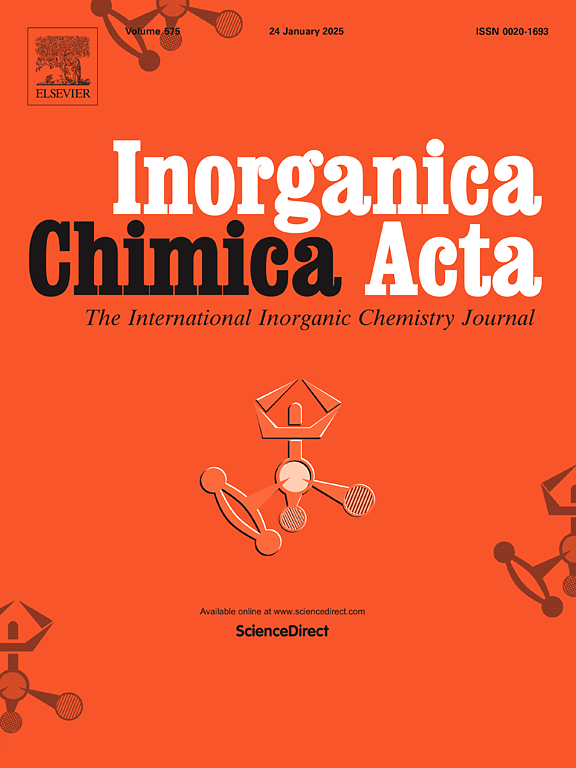一种用于CN离子检测的“裸眼”萘酰亚胺化学传感器:用于试纸、智能手机分析和分子逻辑门及其TD-DFT研究
IF 2.7
3区 化学
Q2 CHEMISTRY, INORGANIC & NUCLEAR
引用次数: 0
摘要
氰化物(CN -)是毒性最大的离子之一,它能干扰人体的生理现象,引起内分泌紊乱、呼吸衰竭、缺氧、血管坏死,甚至死亡。因此,开发经济、灵敏、快速、高效的CN -离子检测方法是十分必要的。采用多步骤合成了萘酰亚胺基高选择性探针1。探针1对氰化物(CN−)离子具有高选择性和特异性,并表现出伴随“关闭”荧光行为的肉眼变化。将CN -离子引入探针溶液后,探针溶液的颜色由黄色变为蓝色。此外,利用光学方法测定了探针1对CN−离子的传感性能。CN−离子的检出限为5.47 μM,结合常数为1.52 × 105 M−1。对氰化物离子的荧光猝灭效率为73.21%,Stern-Volmer猝灭常数为1.22 × 105 M−1。Job’s plot分析显示探针1与CN -离子之间的化学计量结合为1:1,进一步得到FT-IR分析、质量分析、1H NMR滴定和TD-DFT研究的支持。探针1在用试纸法检测CN离子方面找到了它的实际应用。此外,化学上可切换的荧光染料为开发复杂的分子器件提供了有益的基础,这些器件通过调整其发射特性进行通信;因此,探针1也被用来建立分子逻辑门。本文章由计算机程序翻译,如有差异,请以英文原文为准。

A “naked-eye” Naphthalimide based Chemosensor for CN− ion detection: Investigating its application as test-strips, Smartphone Analysis & Molecular Logic gate and its TD-DFT study
It is unanimously known that cyanide (CN−) is one of the most toxic ions because it can interfere with the body's physiological phenomenon causing endocrine disorders, respiratory failure, hypoxia, vascular necrosis, and even death. Therefore, it is essential to develop cost-effective, sensitive, rapid, and efficient methods for sensing CN− ions. The naphthalimide-based highly selective probe 1 was successfully synthesized in a multi-step process. Probe 1 displayed high selectivity and specificity against cyanide (CN−) ion and exhibited naked eye changes accompanied by “turn-off” fluorescence behavior. The introduction of CN− ion into the probe solution shows a visible color change from yellow to blue. Further, the optical methods were employed to determine the sensing performance of probe 1 towards CN− ion. The CN− ion detection limit was 5.47 μM with a binding constant of 1.52 × 105 M−1. The fluorescence quenching efficiency towards cyanide ion was found to be 73.21 %, with the Stern-Volmer quenching constant to be 1.22 × 105 M−1. Job's plot analysis revealed 1:1 stoichiometric binding between probe 1 and CN− ion, further supported by FT-IR analysis, mass analysis, 1H NMR titrations, and TD-DFT study. Probe 1 finds its practical application for detecting CN− ion using the test strip method. In addition, chemically switchable fluorescent dyes provide helpful building blocks for developing intricate molecular devices that communicate via adjustments in their emission characteristics; therefore, probe 1 was also used to establish molecular logic gates.
求助全文
通过发布文献求助,成功后即可免费获取论文全文。
去求助
来源期刊

Inorganica Chimica Acta
化学-无机化学与核化学
CiteScore
6.00
自引率
3.60%
发文量
440
审稿时长
35 days
期刊介绍:
Inorganica Chimica Acta is an established international forum for all aspects of advanced Inorganic Chemistry. Original papers of high scientific level and interest are published in the form of Articles and Reviews.
Topics covered include:
• chemistry of the main group elements and the d- and f-block metals, including the synthesis, characterization and reactivity of coordination, organometallic, biomimetic, supramolecular coordination compounds, including associated computational studies;
• synthesis, physico-chemical properties, applications of molecule-based nano-scaled clusters and nanomaterials designed using the principles of coordination chemistry, as well as coordination polymers (CPs), metal-organic frameworks (MOFs), metal-organic polyhedra (MPOs);
• reaction mechanisms and physico-chemical investigations computational studies of metalloenzymes and their models;
• applications of inorganic compounds, metallodrugs and molecule-based materials.
Papers composed primarily of structural reports will typically not be considered for publication.
 求助内容:
求助内容: 应助结果提醒方式:
应助结果提醒方式:


